Easy (& Affordable) Ideas for Storing Wooden Kid Puzzles
Oh…wooden puzzles! They are so cute and so fun and the kids just love them, but man they can be a pain to store, right?!? With lots of pieces, pegs, and chunky profiles, there aren’t a whole lot of ways to store them so that they stack and stay together but can still be easily played with by little hands. Over the years, I’ve used a variety of different puzzle storage ideas and have definitely honed in on ones that work and ones that don’t. If you’re stumped on the best methods for storing wooden kid puzzles, let me share my time-tested favorites with you!

Why Kid Puzzles Are So Hard to Organize
I will admit up front that I have a love/hate relationship with kid puzzles. I love watching kids learn how to put them together, twisting and turning each piece (and even working through a lot of frustration) until it falls in place just right. And, at least for me, watching a child learn over time exactly how to put a puzzle together is a true joy!
But I don’t love picking up puzzle pieces off the floor all day long…nor do I like constantly losing/finding pieces all over the house (which then results in puzzles that are either incomplete or unusable).
I have a strong hunch any parent can relate to these puzzle woes. But this love/hate relationship also exemplifies why storing wooden puzzles can be so hard: yes, you want your kids to have access to these amazing learning tools, but in a way that is fairly controlled so that your puzzles (and sanity!) remain in tact!
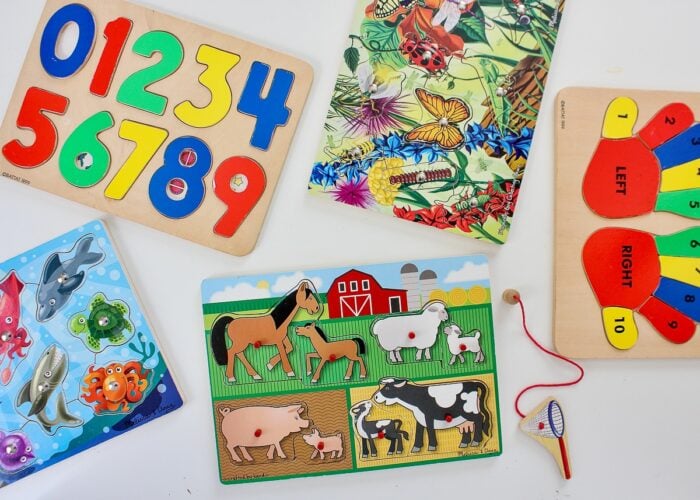

Wooden puzzles are particularly challenging to store because of their variety in shape, size, and features. Some have pegs, some don’t. Some make noises, some don’t. Some pieces sit fully inside their slots, while other pieces are raised up. Some puzzles require accessories (e.g., magnets, fishing poles, wands, etc)…and these accessories may or may not be attached to the puzzle itself. And no two puzzles seem to ever be the exact same size!

Finding the right puzzle solution for your collection and your home may take some trial-and-error…but below are the methods that we found work great for corralling all the little pieces in still really playable ways!
My Favorite Puzzle Storage Solutions
Custom “Puzzle Pouches”
Years and years ago, when my youngest son received some new puzzles, I made these cute “Puzzle Pouches” to hold each one individually. Each pouch has a clear front pocket (so you can easily see which one is which) and a snap-close top (so kids can easily get puzzles in and out). Ten+ years and 2 more kids later, these fabric pouches are still my all-time favorite way to store puzzles.
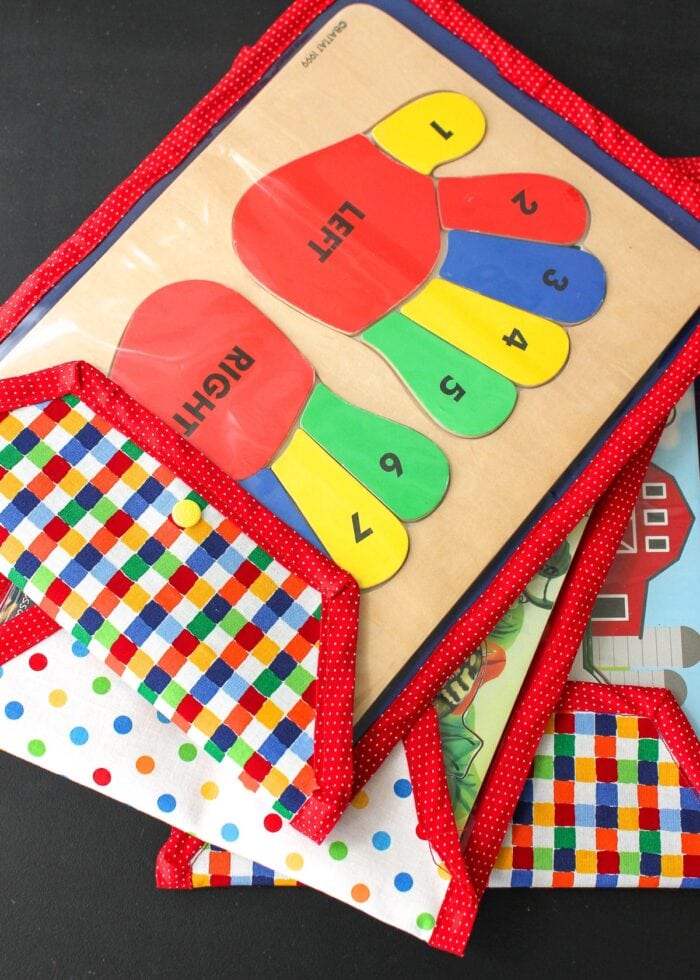
Why? Because I made these puzzle pouches by hand, they fit each puzzle perfectly. So not only do the puzzles slide in and out with complete ease, but the design “hugs” the puzzles just tight enough to hold all the pieces perfectly in place. As a result, these fabric pouches can be stacked on a shelf, placed into bins, or even shelved like books in cubbies…and pieces don’t budge at all.
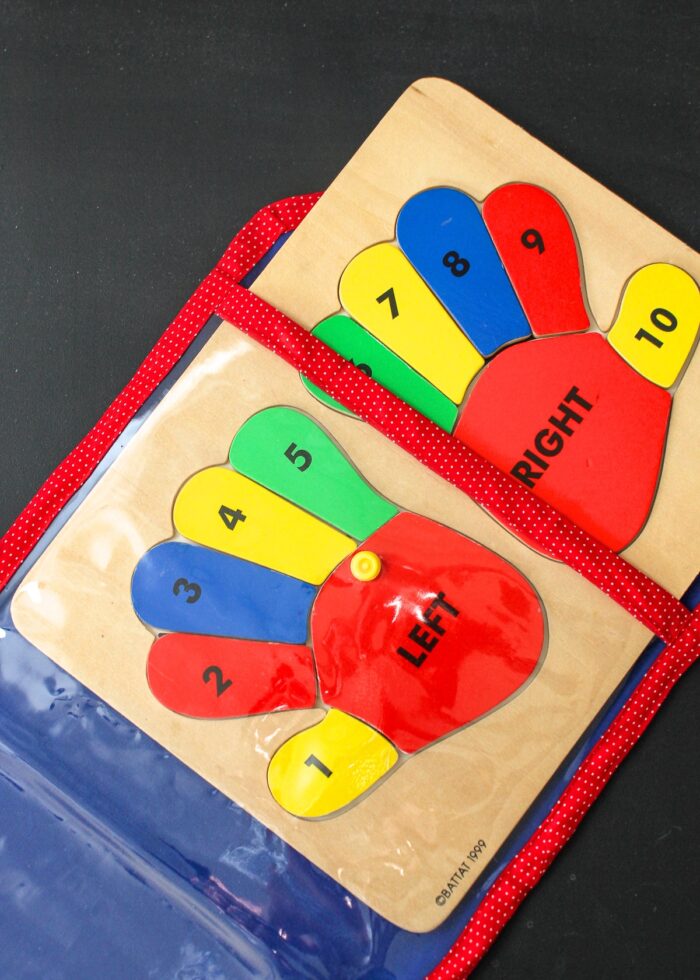
But there’s one major downside to this puzzle storage solution: you have to make them. And since sewing with bias tape is about my least favorite thing to do ever, I never got around to making more as our puzzle collection grew.

If you have the time and love to sew, I definitely recommend these puzzle pouches the most. But if this just isn’t a realistic solution for you, below are some other (easier) methods that also work great!
Zipper Pouches
For Wooden Puzzles
Large zipper pouches (like these and these) work almost exactly the same way as the custom-sewn versions above. Zipper pouches are really inexpensive, waterproof, and come in large sets in a variety of colors (which is convenient if you have tons of puzzles to store). The zippers are easy for little hands to open and shut, and they can also allow you to store puzzles either vertically or horizontally on shelves or inside bigger bins.

My only complaint with these zipper pouches is that they can be a smidge loose, especially depending on the size puzzles you have. As a result, the puzzles aren’t “hugged” quite as tightly as the handmade versions…allowing the pieces to fall out of the puzzle itself (within the pouch). That said, these pouches comfortably hold 2-4 wood puzzles at once (as well as any wand-like accessories), so they are a great option for storing a pile of puzzles in one spot.
For Smaller Puzzles
We discovered these pencil-sized zipper pouches are ideal for small kids puzzles…you know, the kind where you get 6 puzzles in a single box and you have to sort them out based on the icon on the back of each piece?!?
Zipper pouches make it super easy to not just corral all the small pieces but also keep the various puzzles sorted out (which means it’s quicker for kids to just grab a puzzle and get to work!) This same concept could be used with plastic pencil boxes too!
We’ve found that these zipper pouches are more durable and kid-friendly than original cardboard boxes (that always seem to get destroyed). And they also allow us to store lots of puzzles in a single spot (since you can literally just toss them into any toy box, bin or basket). If you’re worried about not knowing which puzzle is which, you can always cut apart the original box and place the reference photo into the correct bag right along with the matching pieces!

Want to make these toy bin labels? See the tutorial: How to Make Picture Toy Bin Labels with a Cricut
Lidded Plastic Bins
If individual zipper pouches seems too tedious for your play needs, my next favorite puzzle storage idea is Sterilite Clip Boxes. These are my go-to storage boxes for a variety of things around the house including LEGO sets, bathroom drawers, and crafts in my craft room. Both the “Deep” and “Large” are the perfect size for holding wooden kid puzzles!

In a single Deep bin, you can easily fit 7-10 wooden puzzles and have room for magnetic wands and accessories (they just slide right into the side!)


The “Large” size holds wooden puzzles really well too…if not a little better (dimension-wise), easily accommodating 3-5 puzzles each. If you need to sort puzzle boxes by child, by type, or by theme, this more shallow version might be worth considering!
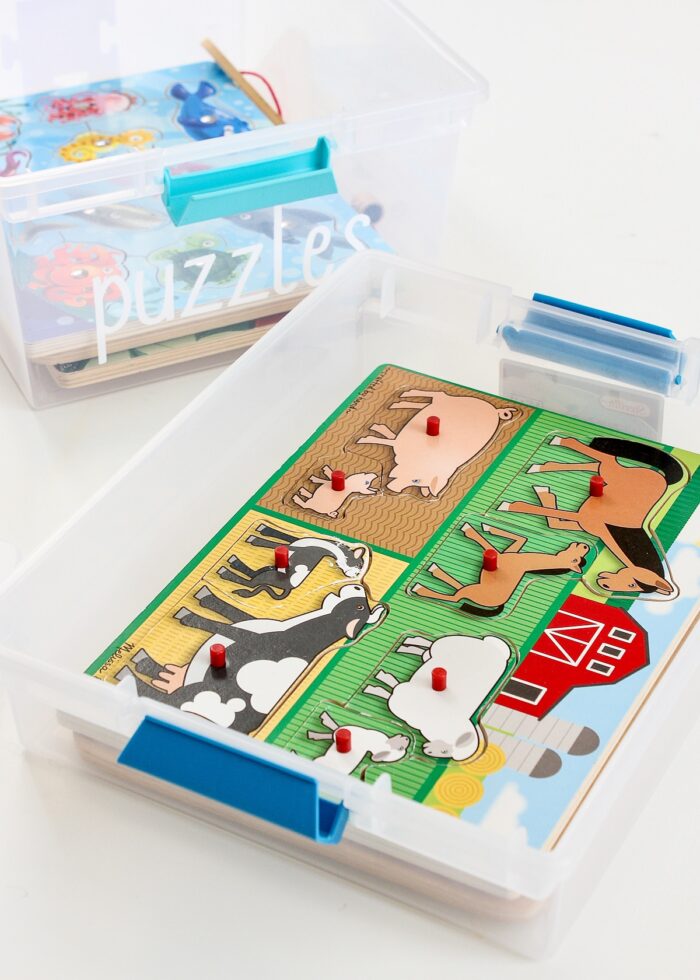
Although these storage bins are clear (making it easy for both kids and adults to see exactly what’s inside), they are also really easy to label with either pictures or words (especially with the help of some vinyl and a Cricut machine!)

Thanks to their lids, the boxes stack and store exceptionally well on shelves, bookcases, and even IKEA Kallax shelving, making them an ideal solution for storing lots of puzzles in a compact yet still really usable way!


Puzzle Storage Shelves & Racks
I’ve personally never used shelves or racks to store our collection of puzzles “out in the open” in our play spaces. Not only do these racks tend to take up more space than I have; but every time we’ve tried, the pieces end up strewn across the playroom and I spend all my time putting puzzles back together.
That said, I realize every family/child/collection is different; so while shelving isn’t ideal for us, I know many households prefer to have their puzzles more easily accessible than inside boxes or pouches. So here are a few clever and affordable options for you to check out!
- This is pretty much the most clever use of FedEx boxes I’ve ever seen.
- If you’re especially handy (of which I am not), this storage tower is pretty amazing.
- What a brilliant use of a scrapbook paper holder/sorter!
- IKEA’s paper sorters are often repurposed to store puzzles!
- And don’t overlook the real deal: a rack and a cubby insert.
Open Baskets
Open bins (like inside an IKEA Kallax) are indeed one of my all-time favorite toy storage methods because of how easy they are to open/close and just toss things in. But this may not be particularly great for puzzles depending on your kids and how they play. Open bins make it all-too-easy for kids to either rummage through or just dump puzzles completely out, creating both a mess and a headache for you!
If open bins are primarily how you like to store toys, I recommend placing it where kids can’t easily reach without supervision or ensure the puzzles are also contained inside zipper pouches.

Where to Keep Your Puzzles
Now…you might see me as a puzzle curmudgeon, but I’ve seriously spent way too much time picking puzzle pieces off the floor, digging them out of couches, and reassembling them on my own long after my kids loose interest. As such, I recommend placing whatever puzzle storage solution you use up high or in a closet where kids can’t easily reach them.
Using clear bins, clear pouches, or even open racks will still allow kids to see the puzzles (and therefor ask to play with them); but placing any of these storage solutions out of easy reach will also allow you to keep it a supervised and controlled activity as needed!
Shop These Puzzle Storage Solutions!
See a solution that might work in your play space? Shop my favorite puzzle storage finds!

1 – Deep Sterilite Boxes | 2 – Large Sterilite Boxes | 3 – Y-Weave Baskets | 4 – IKEA Letter Tray | 5 – Melissa & Doug Puzzle Box | 6 – Melissa & Doug Puzzle Rack | 7 – Small Zipper Pouches | 8 – Large Zipper Pouches | 9 – Plastic Envelopes with Slides
More Great Toy Storage Solutions
Looking for more great toy storage solutions? Here are just a few of our tried-and-true favorites:
- The Best Toy Storage Solutions for Every Item In the Playroom
- How to Store Tiny Toys
- How to Store Wooden Kid Puzzles
- The BEST Way to Organize Board Games
- How to Organize Small Card Games
- How to Organize Play Food
- Device Charging Station in a Drawer
- DIY Dress Up Station for Kids
- How to Sort and Store Those LEGO Sets
- How to Store Kids’ Sports Equipment
- How to Setup a Kids Art Station
- How to Store Kinetic Sand






Without a doubt, well-fitting clear pouches and the Deep Sterilite bins are my all-time favorite puzzle storage methods, but racks can also be a great solution if you have the space. How ever many puzzles you have, I encourage you to find a solution that works for both the kids and adults in your household. This way, everyone can enjoy them without the stress or missing pieces!
Megan









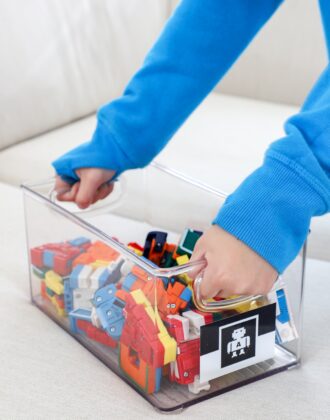
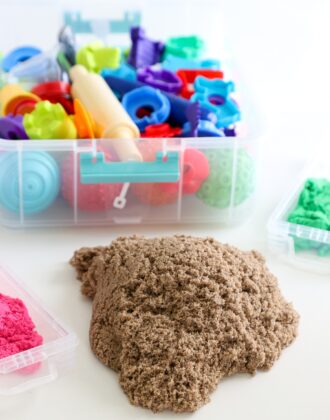
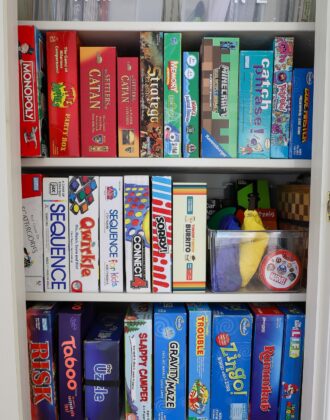

8 Comments on “Easy (& Affordable) Ideas for Storing Wooden Kid Puzzles”
Love it! I have had your original post on the clear envelope puzzle holders saved on my sewing to-do list for so long that my kids have now outgrown these types of puzzles… procrastination win! But a total loss for our puzzles which I struggled to find pieces for when I donated them a few months ago. Wish I’d thought of these bins. I use them everywhere else in my house too! One more thing – sewing with bias tape is MY least favorite thing ever too! High-five, girl!!
Just want to say that I think your new page “look” is terrific!
We used racks we found in the kitchen organization section meant to sort cookie sheets vertically and mounted them horizontally to the wall inside a kallax shelf! They do tend to tip out and fall all over if you bump into them though 🙈
Hi, Megan,
Great ideas! I tried to go to the page that showcased the use of inexpensive paper sorters; surprised to see that the page says one can only view that page “by invitation”!!?? Never heard that one before, I am so disappointed. Any way to replicate that for us?
Anyway, I so enjoy seeing all your ideas,
Thanks!
Hi there!
My guess is the website is giving that “by invitation only” message because they switched it from a public site to a private site. I honestly can’t even remember what the idea was but my hunch is that it was similar to this: https://www.pinterest.com/pin/AcJglfm3LLnhpFblu5JjLu05rNEVcRyJnQXTE_bYPiaWwOm2na-gawE/
Hope that helps!
Megan
Yes! We do many of these. I haven’t thought of the tote storage. That is nice so then they can only get out that box of puzzles for the day and not ALL the puzzles. Another one you can add is that Melissa and Doug makes these elastic puzzle keepers. They’re great for the deep puzzles Melissa and Doug makes or for your chunky puzzles!
Hi!
Okay – so I had to go hunt down these mystical “elastic puzzle keepers” you mentioned because I hadn’t come across them in all my research! It looks like they are only sold with puzzles and not on their own 🙁 Boo – I would buy a dozen, lol! What a clever design concept. Maybe a good future DIY to try!
Thanks so much for sharing!!Megan
My children are grown and now have practically grown grandchildren. When my children were small they had many, many puzzles. Sorting pieces was a nightmare! I learned to assign each puzzle a number or alphabet letter. All pieces plus the puzzle board had this letter/number on the back with a permanent marker. This made it much easier to sort when multiple puzzles were out.